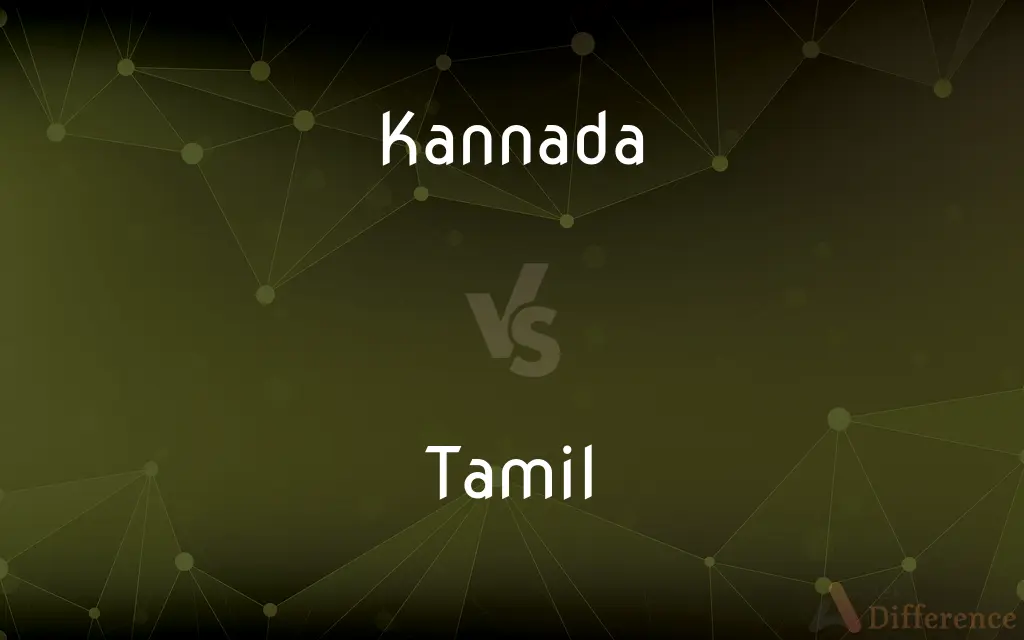Kannada vs. Tamil — What's the Difference?
By Tayyaba Rehman — Updated on October 28, 2023
Kannada and Tamil are distinct Dravidian languages spoken in India, with unique scripts, grammar, and cultural backgrounds.

Difference Between Kannada and Tamil
Table of Contents
ADVERTISEMENT
Key Differences
Kannada is the official language of the Indian state of Karnataka, while Tamil is the official language of Tamil Nadu and an official language in Sri Lanka and Singapore. Both languages belong to the Dravidian language family.
The Kannada script is an abugida of the Brahmic family, while the Tamil script is unique with its own set of characters and is one of the longest-surviving classical languages in the world.
In terms of phonetics, Kannada has more rounded vowels and a slightly different set of consonants compared to Tamil. Tamil is known for its strict adherence to grammatical rules and has a rich literary tradition that dates back over 2000 years.
Kannada literature has a history of over a thousand years and includes a vast array of poetry, prose, and dramatic works. Tamil literature, on the other hand, is one of the oldest in the Indian subcontinent and is renowned for its philosophical depth and poetic excellence.
Both languages have a significant number of speakers, with Kannada being spoken by over 40 million people and Tamil by over 70 million people worldwide.
ADVERTISEMENT
Comparison Chart
Region
Primarily Karnataka, India
Tamil Nadu, India; Sri Lanka; Singapore
Script
Kannada script (Brahmic family)
Tamil script (unique characters)
Phonetics
More rounded vowels, specific consonants
Strict phonetics, less rounded vowels
Literary History
Rich tradition, over a thousand years old
Extremely rich, over 2000 years old
Speaker Count
Over 40 million
Over 70 million
Compare with Definitions
Kannada
A marker of identity for Kannadigas.
Speaking Kannada connects one to Karnataka.
Tamil
A classical Dravidian language.
Tamil is spoken in various parts of the world.
Kannada
A Dravidian language spoken in Karnataka.
Kannada is widely spoken in Bangalore.
Tamil
Central to Tamil people's identity.
Tamil culture is known for its rich traditions.
Kannada
Has a vast literary history.
Kannada literature is a blend of poetry and prose.
Tamil
Boasts ancient literary works.
Tamil literature is renowned for its depth.
Kannada
Uses a distinct Brahmic script.
The Kannada script is elegant and detailed.
Tamil
A language with historical significance.
Tamil is one of the oldest languages in India.
Kannada
Represents Karnataka's culture.
Kannada culture is rich in dance and music.
Tamil
Has a unique script.
Tamil script is an integral part of its literature.
Kannada
Kannada (; ಕನ್ನಡ, [ˈkɐnːɐɖa]; less commonly known as Kanarese) is a Dravidian language spoken predominantly by the people of Karnataka in the southwestern region of India. The language is also spoken by linguistic minorities in the states of Maharashtra, Andhra Pradesh, Tamil Nadu, Telangana, Kerala and Goa; and also by Kannadigas abroad.
Tamil
A member of a Dravidian people of southern India and northern Sri Lanka.
Kannada
A Dravidian language related to Telugu and using a similar script, spoken mainly in Karnataka in south-western India.
Tamil
The Dravidian language of the Tamil.
Kannada
Relating to the language Kannada.
Tamil
Of or relating to the Tamil or their language or culture.
Kannada
The principal Dravidian language spoken in the Indian state of Karnataka.
Tamil
Of or pertaining to the Tamils, or to their language.
Kannada
A Dravidian language spoken in southern India
Tamil
One of a Dravidian race of men native of Northern Ceylon and Southern India.
Tamil
A member of the mixed Dravidian and Caucasoid people of southern India and Sri Lanka
Tamil
The Dravidian language spoken since prehistoric times by the Tamil people in southern India and Sri Lanka
Tamil
Of or relating to a speaker of the Tamil language or the language itself;
The Tamil Tigers are fighting the Sinhalese in Sri Lanka
Tamil agglutinative phrases
Common Curiosities
Are there shared words between Kannada and Tamil?
Yes, due to their Dravidian roots, some words are similar.
Is Kannada similar to Tamil?
They are related but distinctly different Dravidian languages.
Can Tamil speakers easily understand Kannada?
Not necessarily, as they have different linguistic structures.
Is the Kannada script derived from Sanskrit?
It's part of the Brahmic family but not directly from Sanskrit.
Do Kannada and Tamil have the same grammar?
They have similar roots but distinct grammatical rules.
Is Tamil one of the oldest languages in the world?
Yes, Tamil is one of the longest-surviving classical languages.
Are there Tamil-speaking communities outside India?
Yes, especially in Sri Lanka, Singapore, and Malaysia.
Are Kannada movies popular in Tamil Nadu?
They have a niche audience, but Tamil cinema is dominant.
Has Tamil received classical language status?
Yes, Tamil has been recognized as a classical language.
How many letters are in the Kannada alphabet?
The Kannada script has 49 phonemic letters.
Is the Tamil script used in other languages?
Primarily for Tamil, but influences are seen in others.
Is Tamil taught in schools outside Tamil Nadu?
In some regions and countries due to the Tamil diaspora.
Can I find Kannada content online?
Yes, there's a growing presence of Kannada content online.
Does Kannada literature include classical texts?
Yes, it has a rich tradition of classical and modern texts.
Share Your Discovery

Previous Comparison
Treggings vs. Legging
Next Comparison
Cash vs. CacheAuthor Spotlight
Written by
Tayyaba RehmanTayyaba Rehman is a distinguished writer, currently serving as a primary contributor to askdifference.com. As a researcher in semantics and etymology, Tayyaba's passion for the complexity of languages and their distinctions has found a perfect home on the platform. Tayyaba delves into the intricacies of language, distinguishing between commonly confused words and phrases, thereby providing clarity for readers worldwide.














































